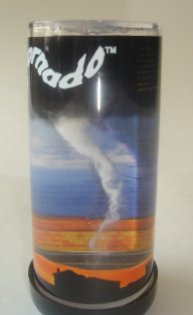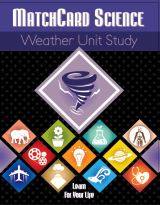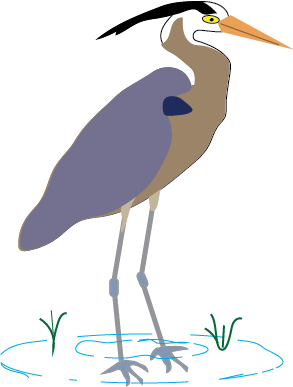Pet Tornado
Just ask any kid how to use a pet tornado and they will show you: you just turn the bottle clock wise and watch the destructive funnel appear. But in this case, you can watch it in the safety of your own home - even your own hand.

We have had one of these floating around the house for decades (okay, it does get replaced now and then.) It shows up behind the couch or under the bed, and once again the mighty cyclones start swirling.
But besides the obvious task of simply playing with the gadget, there are some educational activities that increase the scholastic value of having a pet tornado in your home (aside, of course, from the fact that it neither eats or eliminates. The perfect pet!)
Twister Timing
Have a contest to see who can make a tornado which lasts the longest. You will need either a stop watch or watch with a second hand.Two Substances
When the jar is still it looks like there is only one substance: clear water. If it is shaken, you can see the mixing of two substances.Shake it vigorously, then set it down and watch the substances separate. A light behind the jar will show the iridescent particles more clearly.
Understanding that there are two different substances interacting, helps the student understand the formation of tornadoes.
Coriolis Effect
Shake the tornado up and down. Nothing happens. Side to side - still nothing. Only by turning it in a circular motion do you get the twister formation.Again, refer the student to the fact that there are two different substances in the jar. When they separate, there is a layer where they are in contact.
With real tornadoes, the two substances are hot and cold air. But what motion would make the two different types of air swirl clockwise to form the twister? (Answer: the earth spinning)
Hold the pet tornado or any other object representing two substances over a globe. As the globe turns, it creates the coriolis effect.
Make Your Own Pet Tornado
This homemade tornado isn't quite as much fun, and it certainly won't last as long. Making it, however, will help educate the student on how the real torandoes (and their pet versions) work.You will need: a drinking bottle or jar that closes; water; 1/4 cup of dish soap or liquid hand soap; one tablespoon of vinegar.
Directions: Put the soap and vinegar in the bottle. Fill the bottle with water so it is 2/3 to 3/4 full. Add the cap, and swirl away.
Yes: You can add lego people, or other tiny victims if you are so inclined. I won't guarantee the academic or character-building value of this; but it entertains some folks.
Compare: the homemade tornado, the pet tornado, and the formation of real tornadoes.
Tornado tubes
The tornado tubes are another way of studying the vortex. Usually, two liter bottles are connected by way of a plastic connector. If you don't happen to have a connector, and want to save the money of purchasing it, you can try to make it yourself.How to make your own tornado tube.
Get two empty 2-liter bottles. Add water to one, and set it on the floor. Turn the other bottle upside down so that the tops are together. Use a generous amount of conduction tape or other strong tape to connect the bottles. Expect some leakage, so I wouldn't do this on a floor prone to water damage.
Turn the bottles so the bottle full of water is on the top. Give it a clockwise and spin and viola, another twister.
In this case the two substances are the water in the top bottle and the air being displaced from the bottom bottle as water fills it.
Study Centripetal Forces
That's a fancy way of saying "circular force" or "center seeking force"- and makes a great spelling word for the insatiable speller.A centripetal force draws objects towards the center. What would happen to a person or object caught in a tornado? You can calculate this force with the following formula:
Force = (mass)(velocity squared) divided by (radius of twister)
Can you think of other examples of centripetal forces? (Answers: bathtub and toilet)Fujiata Scale
This scale calculates the severity of a tornado.- F0 Minor Damage 48-72 mph; 10 - 50 yards of damage done
- F1 Moderate 73-112 mph; 30 - 150 yards
- F2 Considerable 113-157 mph; 110-250 yards
- F3 Critical 158-206 mph; 200-500 yards
- F4 Severe 207-260 mph; 400-900 yards
- F5 Devastating 261-318 mph; 1100+ yards
Hurricane and Tornado MatchCard

Would you like to compare a tornado and hurricane?
Learn about the difference between these two intriguing storms. Suggestions for other activities are presented.
MatchCard Science
How To Use MatchCards

Download the FREE MatchCard Science Instructor's Guide and see how MatchCards can make building their science knowledge base fun.
Weather Unit Study

Nine different weather lessons can be presented in this 4 week study.
Download the entire Weather Unit Study.
12 Science Unit Studies

Chemistry is only one of twelve complete unit studies for kids in 3rd to 8th grade.
Comprehensive objectives, hands-on projects, suggested science fair experiments, and the fun game-like MatchCards keep them interested in learning science. See all twelve MatchCard Science Unit Studies.
About Our Site
Hands-On Learning













